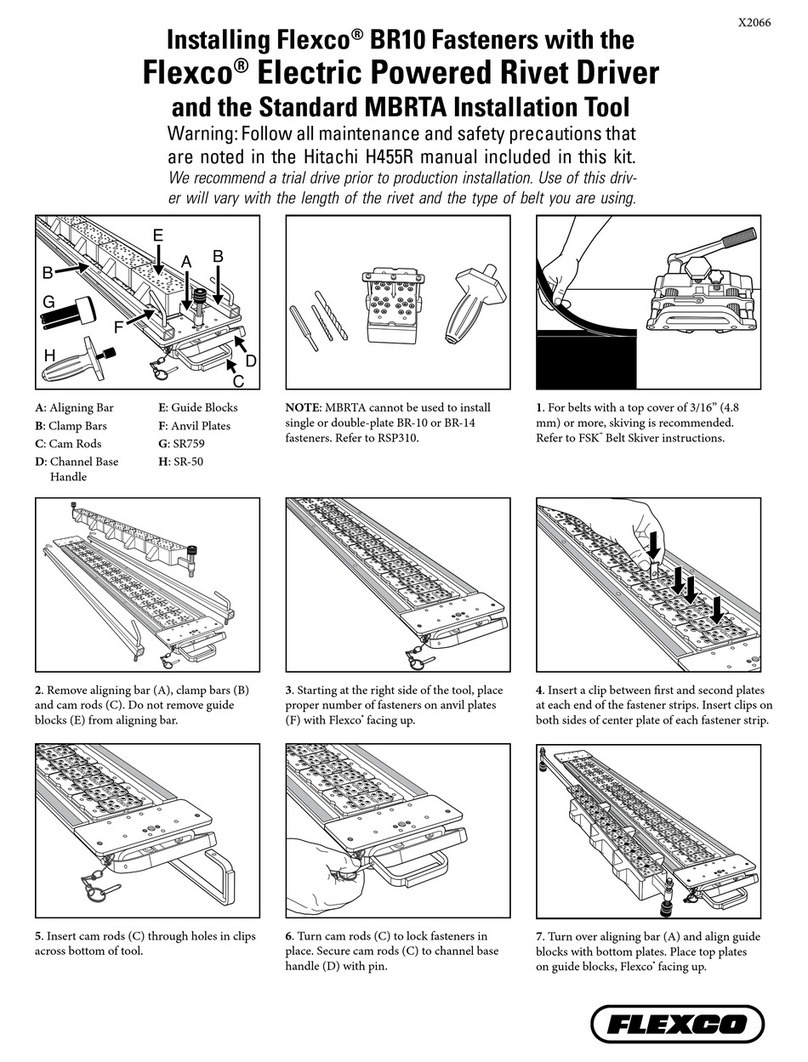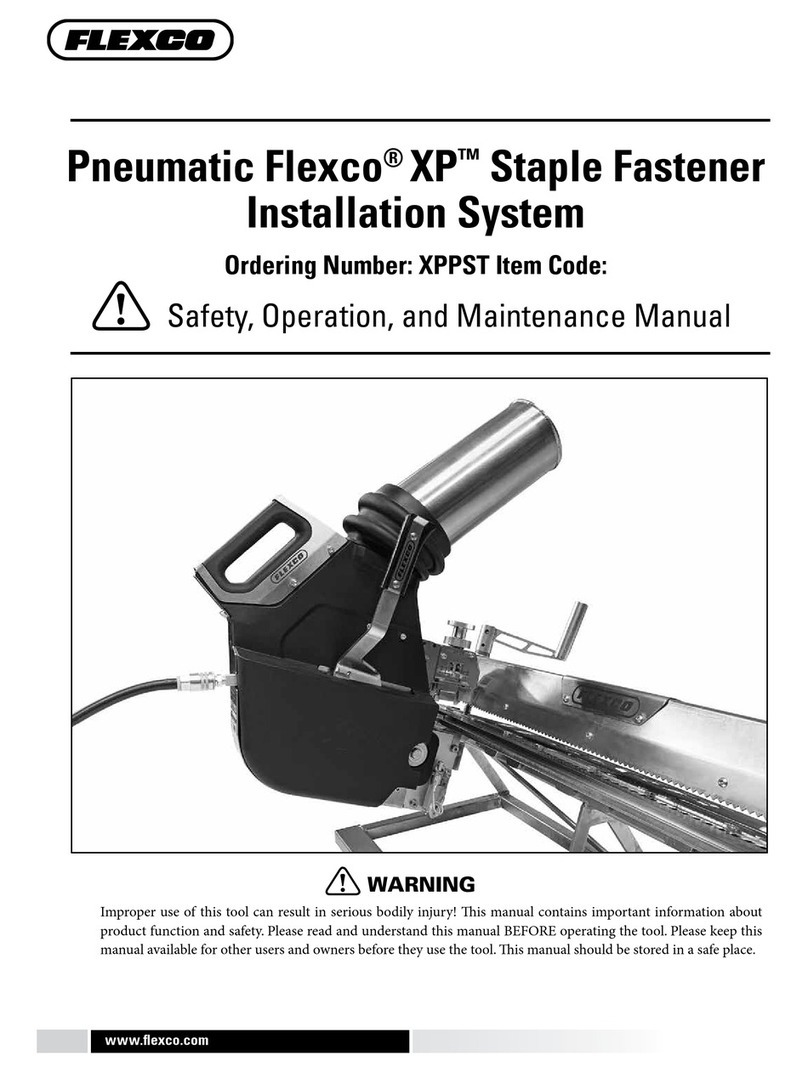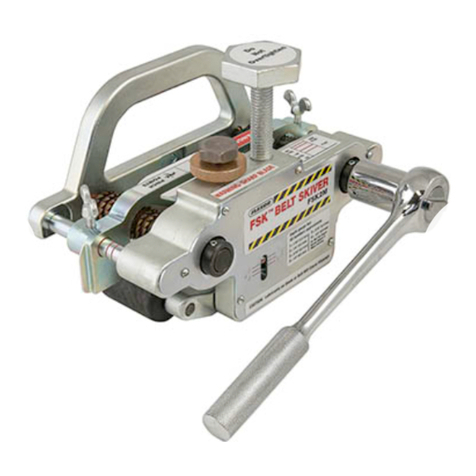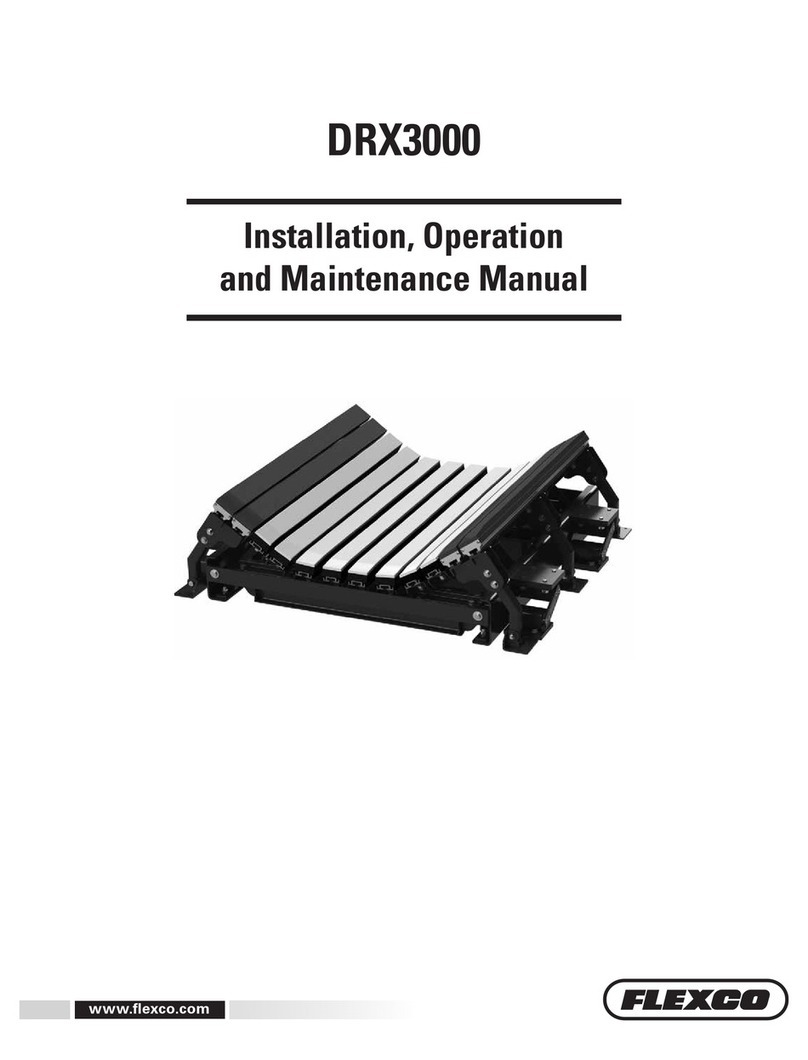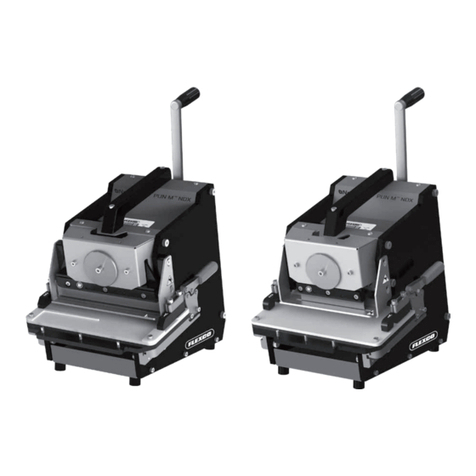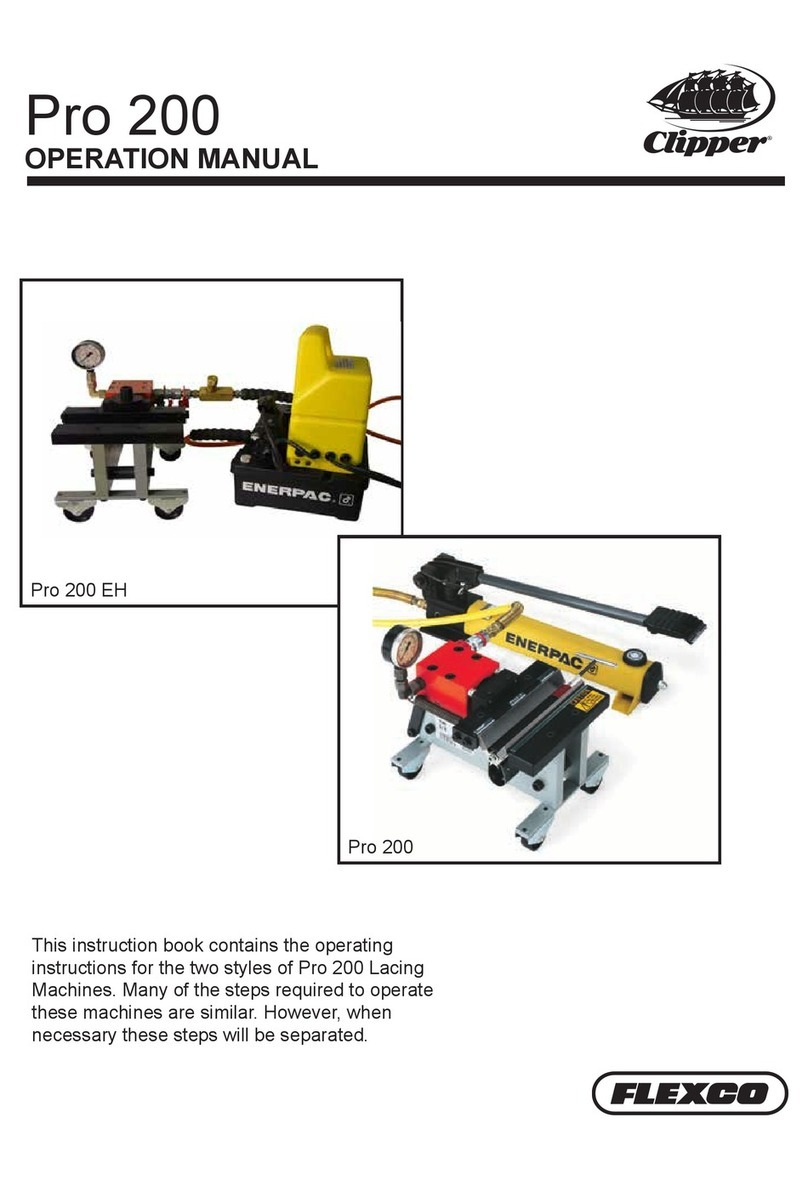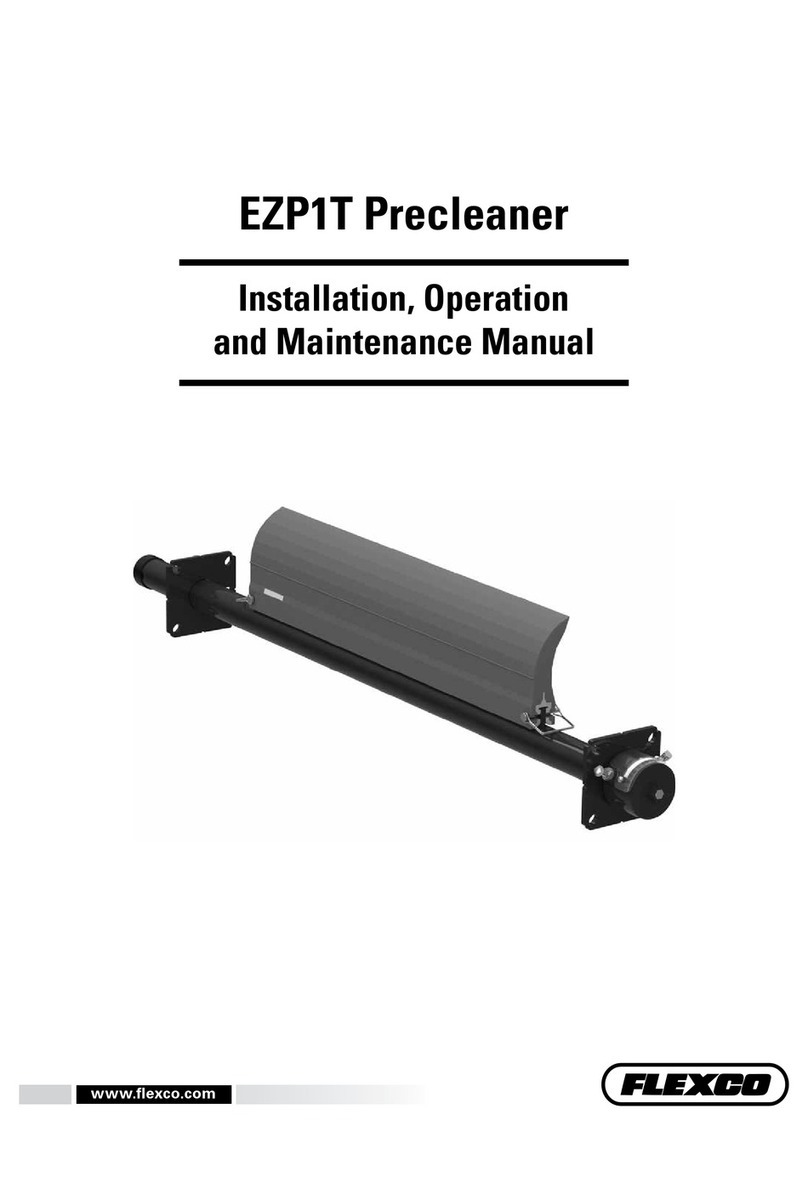Flexco Standard-Duty PTEZ User manual

PTEZ™Belt Trainer
Installation, Operation
and Maintenance Manual
www.flexco.com
www.flexco.com
Standard-Duty PTEZ
Heavy-Duty PTEZ

2PTEZ™Belt Trainer
PTEZ™Belt Trainer
Serial Number: _____________________________________________________________
Purchase Date:______________________________________________________________
Purchased From: ____________________________________________________________
Installation Date: ____________________________________________________________
Serial number information can be found on the Serial Number Label
on the product.
is information will be helpful for any future inquiries or questions
about belt cleaner replacement parts, specications or troubleshooting.

3
Section 1 - Important Information ...................................................................................................4
1.1 General Introduction...........................................................................................................................4
1.2 User Benets .........................................................................................................................................4
1.3 Proper Belt Trainer Selection..............................................................................................................5
Section 2 - Safety Considerations and Precautions ..........................................................................6
2.1 Stationary Conveyors...........................................................................................................................6
2.2 Operating Conveyors...........................................................................................................................6
Section 3 - Pre-Installation Checks and Options..............................................................................7
3.1 Checklist................................................................................................................................................7
3.2 Optional Installation Accessories.......................................................................................................8
Section 4 - Installation Instructions..................................................................................................9
4.1 PTEZ ......................................................................................................................................................9
4.2 HD PTEZ.............................................................................................................................................12
Section 5 - Pre-Operation Checklist and Testing............................................................................16
5.1 Pre-Op Checklist................................................................................................................................16
5.2 Test Run the Conveyor ......................................................................................................................16
Section 6 - Maintenance...................................................................................................................17
6.1 New Installation Inspection..............................................................................................................17
6.2 Routine Visual Inspection.................................................................................................................17
6.3 Routine Physical Inspection .............................................................................................................17
6.4 Roller Replacement Instructions......................................................................................................18
6.5 Maintenance Log................................................................................................................................19
6.6 Maintenance Checklist ......................................................................................................................20
Section 7 - Troubleshooting ............................................................................................................21
Section 8 - Specs and CAD Drawings..............................................................................................22
8.1 CAD Drawing - PTEZ.......................................................................................................................22
8.2 CAD Drawing - HD PTEZ................................................................................................................23
8.3 CAD Drawing - HD PTEZ Underground ......................................................................................24
Section 9 - Replacement Parts .........................................................................................................25
9.1 Replacement Parts List - PTEZ ........................................................................................................25
9.2 Replacement Parts List - HD PTEZ.................................................................................................26
Section 10 - Other Flexco Conveyor Products ................................................................................27
Table of Contents

4PTEZ™Belt Trainer
Section 1 - Important Information
1.1 General Introduction
We at Flexco are very pleased that you have selected a PTEZ™ Belt Trainer for your conveyor system.
is manual will help you to understand the installation, operation and maintenance of this product and assist
you in making it work up to its maximum eciency over its lifetime of service.
It is essential for safe and ecient operation that the information and guidelines presented be properly
understood and implemented. is manual will provide safety precautions, installation instructions,
maintenance procedures and troubleshooting tips. In addition, please follow all standard, approved safety
guidelines when working on your conveyor.
If, however, you have any questions or problems that are not covered, please visit our web site or contact our
Customer Service Department:
Customer Service: 1-800-541-8028
Visit www.exco.com for other Flexco locations and products.
Please read this manual thoroughly and pass it on to any others who will be directly responsible for installation,
operation and maintenance of this belt trainer. While we have tried to make the installation and service tasks
as easy and simple as possible, this product does however require correct installation and regular inspection
and maintenance to maintain top working condition.
1.2 User Benets
Belt mistracking is a common problem that produces various problems, ranging from belt and structure damage
to product spillage and safety issues. By utilizing the PTEZ™, it is possible to correct a belt that is mistracking and
causing these problems. Multiple units may be required depending on the length of the mistracking belt.

5
Section 1 - Important Information
1.3 Proper Belt Trainer Selection
Belt Positioner™
PT Max™
Top Side
PT Max™
Return Side
PT Pro™
PTEZ™
PT Smart™
Standard
MODEL APPLICATION RANGE
Belt Positioner™
Return side only, 800 PIW max tension on Small,
Medium and Large; 1200 PIW max tension on Extra
Large. Also works on reversing belts.
PTEZ™
Medium-duty belts up to 1600 PIW max tension.
Also works on reversing belts. Belt width 18"-48"
(450 - 1200mm).
PT Smart™
Medium-duty belts up to 1600 PIW max tension.
Belt width 42" - 84" (050 - 2100mm). Belt thickness
1" (25mm) maximum.
HD PTEZ™
Medium-duty belts up to 2400 PIW max tension.
Belt widths + 9" (225mm) idler. Belt thickness 1"
(25mm) maximum. Also works on reversing belts.
PT Pro™
Medium-duty belts 150 PIW min to 1600 PIW max
tension. Belt width 18" - 72" (450 - 1800mm). Also
works on reversing belts.
HD PT Pro™
Heavy-duty belts 300 PIW min to 2400 PIW max
tension. Belt width 48" - 96" (1200 - 2400mm). Also
works on reversing belts.
PT Max™
Heavy-duty belts up to 3000 PIW max
Generally 3/4" to 1" thick (19mm to 25mm)
Belt width 24" - 60" (600 - 1500mm)
HD PT Max™Heavy-duty belts up to 6000 PIW max tension. Belt
width 54" - 84" (1350 - 2100mm)
HD PTEZ™
Conveyor Criteria Belt
Positioner™PTEZ™
Heavy
Duty
PTEZ™
PT Smart™PT Pro™
Heavy
Duty
PT Pro™
PT Max™
Heavy
Duty
PT Max™
Super
Duty
PT Max™
Top side mistracking No No No No No No Yes Yes Yes
Return side mistracking Yes Yes Yes Yes Yes Yes Yes Yes Yes
Reversing Yes Yes Yes No Yes Yes No No No
Belt mistracking to one side Better Better Better Better Better Better Better Better Better
Belt mistracking to both sides Acceptable Better Better Best Better Better Best Best Best
Inconsistent tracking problem Good Better Better Best Better Better Best Best Best
Belt is cupped (heavy) Best ‡ Better ‡ Better ‡ Better Better Better Better Better Better
Belt has edge damage Best Best Best Good Best Best Good Good Good
Ease of Installation Best Better Better Good Good Good Good Good Good
Belt has low running tension (150-300 PIW) Good Good Good Good Good N/A Good N/A N/A
Belt has medium running tension (300-1600 PIW) Better Better Better Better Better Better Best Best Best
Belt has high running tension (1600+ PIW) N/A N/A N/A N/A N/A Best Better Best Best
Approx. "upstream" effect *∆ 50' (15 M) 20' (6 M) 20' (6 M) 20' (6 M) 20' (6 M) 20' (6 M) 50' (15 M) 50' (15 M) 50' (15 M)
Approx. "downstream" effect *∆ 50' (15 M) 100' – 120'
(30 – 36 M)
100' – 120'
(30 – 36 M)
120' – 150'
(36 – 45 M)
100' – 120'
(30 – 36 M)
100' – 120'
(30 – 36 M)
150' – 200'
(45 – 61 M)
150' – 200'
(45 – 61 M)
150' – 200'
(45 – 61 M)
‡ Installed on the clean side of the return belt
* Typical results; actual results may vary
∆ Disc idlers have the potential to reduce these numbers

6PTEZ™Belt Trainer
Section 2 - Safety Considerations and Precautions
Before installing and operating the PTEZ™ Belt Trainer, it is important to review and understand the following safety
information.
ere are setup, maintenance and operational activities involving both stationary and operating conveyors. Each case
has a safety protocol.
2.1 Stationary Conveyors
e following activities are performed on stationary conveyors:
• Installation • Idler replacement
• Cleaning • Repairs
DANGER
DANGER
WARNING
WARNING
WARNING
!
!
!
!
!
It is imperative that OSHA/MSHA Lockout/Tagout
(LOTO) regulations, 29 CFR 1910.147, be followed
before undertaking the preceding activities. Failure to
use LOTO exposes workers to uncontrolled behavior of
the belt trainer caused by movement of the conveyor belt
or belt trainer. Severe injury or death can result.
Before working:
• Lockout/Tagout the conveyor power source
• Clear the conveyor area where work is to take place
Use Personal Protective Equipment (PPE):
• Safety eyewear
• Hardhats
• Safety footwear
Close quarters and heavy components create a worksite
that compromises a worker’s eyes, feet and skull.
PPE must be worn to control the foreseeable hazards
associated with conveyor belt components. Serious
injuries can be avoided.
2.2 Operating Conveyors
ere are two routine tasks that must be performed while the conveyor is running:
• Inspection of belt trainer performance
• Dynamic troubleshooting
Every belt conveyor is an in-running nip hazard. Never
touch or prod an operating belt trainer. Conveyor
hazards cause instantaneous amputation and entrapment.
Never adjust anything on an operating belt trainer.
Flailing hardware can cause serious injury or death.
Conveyors contain moving hazards. Stay as far from the
trainer as practical and use safety eyewear and headgear.

7
3.1 Checklist
•Check the model and size of the belt trainer. Is it the right one for your beltline?
• Check the PTEZ™ to be sure all the parts are included in the shipment.
– Trainer
–
Mounting hardware
–Instruction kit
• Find the information packet in the shipment
• Review the “Tools Needed” section on the front of the installation instructions.
• Prepare the conveyor site:
– Identify the point(s) of mistracking, expecting 100'- 120' (30-37 M) of downstream inuence.
– Position the unit 20'(6.1 M) aer the start of the mistracking.
– Identify an opening of at least 9" (225mm) for Standard Duty, 10.5" (265mm) for Heavy Duty if possible to
avoid interference with roller during installation.
– Remove old tracking devices.
– If the conveyor has disc idlers, replace one idler before and one idler aer the location where the trainer
will be installed with a standard idler.
– If the conveyor has V-return idlers, replace one idler before and aer where the trainer will be located with
a standard at idler.
Section 3 - Pre-installation Checks and Options

8PTEZ™Belt Trainer
3.2 Optional Installation Accessories
Optional tools can make the installation of the PTEZ™ Belt Trainer easier and faster.
Section 3 - Pre-Installation Checks and Options (cont.)
Flex-Lier™ Conveyor Belt Lier
e Flexco Flex-Lier makes the job of liing the
conveyor belt easy and safe. Using two Flex-Liers,
the belt can be quickly lied out of the way to install
the PTEZ™. e Flex-Lier has the highest safe
li rating available at 4000 lbs (1810 kg). And it’s
versatile. It can also be used to li topside or return
side belt for splicing, roller replacement or other
maintenance jobs. Available in three sizes: Medium
for belt widths 36" - 60" (900 - 1500mm), Large for
belt widths 48" - 72" (1200 - 1800mm), and XL for
belt widths 72" - 96" (1800 - 2400mm).
Flex-Lifter™ Conveyor Belt Lifter
Description Ordering
Number
Item
Code
Medium Flex-Lifter 36" - 60" (900 - 1500mm) FL-M 76469
Large Flex-Lifter 48" - 72" (1200 - 1800mm) FL-L 76470
XL Flex-Lifter 72" - 96" (1800-2400mm) FL-XL 76983

9
Mounting Bracket
Main Shaft
Bracket
Main Shaft
Dust Cover
9" (225mm)
9" (225mm)
Roller
Section 4 - Installation Instructions - PTEZ™
Physically lock out and tag the conveyor at the power source
before you begin belt trainer installation.
CAUTION: Components may be heavy. Use safety-approved liing procedures.
Before You Begin:
• A serial number label is located in the instruction packet. Following
installation, please locate space on or near the PTEZ to apply this label.
Please use this number in any correspondence.
• Use the necessary mechanical liing equipment (crane, come-alongs,
etc.) for safe installation.
• e trainer should not be positioned closer than 20 feet (6M) from the
tail pulley, take-up pulleys, or head pulley.
• Follow all safety precautions when using a cutting torch.
Tools Needed:
• Tape Measure
• (2) 3/4" Wrenches (19mm)
• Medium or Large Adjustable Wrench
• Cutting Torch/Welder
• (2) Come-Alongs (3/4 Ton
Minimum)
• Any necessary equipment
for moving and liing heavy
components
• Straightedge or Level
• Marking Pen
4.1 PTEZ™
Conveyor Site Preparation:
• Identify the point(s) of mistracking, expecting 100'- 120' (30-37 M)
of downstream inuence.
• Position the unit 20' (6 M) aer the start of the mistracking.
• Identify an opening of at least 9" (225mm).
• Remove any existing tracking devices that fall in the estimated
tracking range of the PTEZ as multiple dierent tracking devices
may reduce or prevent the PTEZ from tracking as intended.
Main Shaft
End Cap

10 PTEZ™Belt Trainer
Section 4 - Installation Instructions - PTEZ™
4.1 PTEZ
3. Position mounting brackets. May be mounted to
existing idler hole patterns. Overall range of adjustment
on brackets is 1-5/8" (41mm) above the top ange or 3
(76mm) below the top ange (Fig. 3).
1. Identify location for PTEZ and mount one bracket.
a. For push-up installation, use a straightedge to push up
against the belt to remove the slack and make a mark on
the bracket for the bottom of the belt. From that mark,
measure down 3" (75mm) and make a second mark
(Fig. 1). e second mark is where the center of the pole
should line up in Step 6.
b. For push-down or clean-side installation, use a
straightedge to push down against the belt to remove the
slack and make a mark on the bracket for the top of the
belt. From that mark, measure up 3" and make a second
mark. e second mark is where the center of the pole
should line up in Step 6.
2. Li the belt approximately 3" (76mm) where the trainer
will be installed. Remove existing idler (if applicable)
(Fig. 2). NOTE: If the conveyor has disc idlers, replace
one idler with a standard idler before and aer the
location where the trainer will be installed.
Fig. 2
Fig. 3
Fig. 1
Lift Belt 3" (75mm)
Main Shaft Bracket
Finger-tighten bolt
Equal Distance
3"
(76mm)
1-5/8"
(41mm)
STRUCTURE
BELT
BELT
3" (75mm)
+
PTEZ Preparation and Installation:
5. Slide on the main sha brackets. Finger-tighten bolts
for further adjustment later (Fig. 5).
4. Square the mounting brackets. Measure from a xed
location on both sides to ensure alignment (Fig. 4).
Fig. 4
Fig. 5

11
Align center of
shaft with mark
Finger-tighten
bolts
Equal
Arrows must point to belt
STRUCTURE
BELT
Section 4 - Installation Instructions - PTEZ™
6. Li the roller and main sha bracket assembly. Be sure to use safe and secure liing procedures to li the PTEZ
into position. Ensure the arrows on main sha label point up or down towards the belt (Fig. 6a).Align center of
sha with mark on mounting bracket (from Step 1) and nger-tighten bolts between the mounting bracket and
main sha bracket (Fig. 6b).
Fig. 6a
4.1 PTEZ
7. Ensure main sha is centered on main sha
brackets (equal length showing on both sides of
roller) (Fig. 7).
9. Tighten all bolts, install end caps on main sha, and
proceed to pre-op checklist on page 12.
8. Lower the belt onto the roller. Ensure belt completely
contacts roller. Raise extending brackets one hole
if there is not good contact (Fig. 8). Belt should be
pushed up or down approximately 1/2" to 1" (12-
25mm) from normal running height. If there is still a
gap between the PTEZ and the belt, adjustments may
be made in 1/2" (12mm) increments until the gap
disappears. NOTE: If gap persists consider push-down
installation.
Fig. 6b
Fig. 7
Fig. 8
Roller
Roller
Belt
Belt
INCORRECT - raise roller
CORRECT

12 PTEZ™Belt Trainer
Section 4 - Installation Instructions - PTEZ™
Physically lock out and tag the conveyor at the power source
before you begin belt trainer installation.
CAUTION: Components may be heavy. Use safety-approved liing procedures.
Before You Begin:
• A serial number label is located in the instruction packet.
Following installation, please locate space on or near the
HD PTEZ to apply this label. Please use this number in any
correspondence.
• Use the necessary mechanical liing equipment (crane, come-
alongs, etc.) for safe installation.
• e trainer should not be positioned closer than 20 feet (6M)
from the tail pulley, take-up pulleys, or head pulley.
• Follow all safety precautions when using a cutting torch.
Tools Needed:
• Tape Measure
• (2) 3/4" Wrenches (19mm)
• Medium or Large Adjustable Wrench
• Cutting Torch/Welder
• (2) Come-Alongs (3/4 Ton Minimum)
• Any necessary equipment for moving and
liing heavy components
• Straightedge or Level
• Marking Pen
4.2 HD PTEZ™
Conveyor Site Preparation:
• Identify the point(s) of mistracking, expecting 100'- 120' (30-37 M
of downstream inuence.
• Position the unit 20' (6 M) aer the start of the mistracking.
• Identify an opening of at least 12" (305mm).
• Remove any existing tracking devices that fall in the estimated
tracking range of the HD PTEZ as multiple dierent tracking
devices may reduce or prevent the HD PTEZ from tracking as
intended.
Mounting Bracket
Main Shaft
Dust Cover
Roller
Main Shaft
Bracket
Main Shaft
End Cap
15" (381mm)
12" (305mm)

13
Section 4 - Installation Instructions - PTEZ™
4.2 HD PTEZ™
1. Identify location for HD PTEZ and mount one bracket.
a. For push-up installation, use a straightedge to push up
against the belt to remove the slack and make a mark
on the bracket for the bottom of the belt. From that
mark, measure down 3.5" (90mm) and make a second
mark (Fig. 1). e second mark is where the center of
the pole should line up in Step 6.
b. For push-down or clean-side installation, use the
weight of the roller to deect the belt and remove
cupping. Mount brackets to structure and check
position of mounting holes. Push unit down 1/2"
(50mm) more and bolt in place. Conrm no daylight.
2. Li the belt approximately 5" (125mm) where the
trainer will be installed. Remove existing idler (if
applicable) (Fig. 2). NOTE: If the conveyor has disc
idlers, replace one idler with a standard idler before and
aer the location where the trainer will be installed.
3. Position mounting brackets. May be mounted to
existing idler hole patterns. Overall range of adjustment
on brackets is 1-1/4" (32mm) above the top ange or
8-3/4" (222mm) below the top ange (Fig. 3).
4. Square the mounting brackets. Measure from a xed
location on both sides to ensure alignment (Fig. 4).
5. Slide on the main sha brackets. Finger-tighten bolts
for further adjustment later (Fig. 5).
Fig. 2
Fig. 3
Fig. 1
Lift Belt 5" (125mm)
Main Shaft Bracket
Finger-tighten bolt
8-3/4"
(222mm)
1-1/4"
(32mm)
STRUCTURE
BELT
BELT
3.5" (90mm)
+
PTEZ Preparation and Installation:
For Underground J-bolt or wire rope mounting, see page 15.
Fig. 4 Fig. 5
Equal Distance

14 PTEZ™Belt Trainer
Align center of
shaft with mark
Finger-tighten
bolts
Equal
Arrows must point to belt
BELT
Section 4 - Installation Instructions - PTEZ™
6. Li the roller and main sha bracket assembly. Be sure to use safe and secure liing procedures to li the HD
PTEZ into position. Ensure the arrows on main sha label point up or down towards the belt (Fig. 6a).Align center
of sha with mark on mounting bracket (from Step 1) and nger-tighten bolts between the mounting bracket and
main sha bracket (Fig. 6b).
Fig. 6a
4.2 HD PTEZ™
7. Ensure main sha is centered on main sha
brackets (equal length showing on both sides of
roller) (Fig. 7).
9. Tighten all bolts, install end caps on main sha, and
proceed to pre-op checklist on page 12.
8. Lower the belt onto the roller. Ensure belt completely
contacts roller. Raise extending brackets one hole
if there is not good contact (Fig. 8). Belt should be
pushed up or down approximately 1/2" to 1" (12-
25mm) from normal running height. If there is still a
gap between the HD PTEZ and the belt, adjustments
may be made in 1/2" (12mm) increments until the gap
disappears. NOTE: If gap persists consider push-down
installation.
Fig. 6b
Fig. 7
Fig. 8
Roller
Roller
Belt
Belt
INCORRECT - raise roller
CORRECT
STRUCTURE

15
Section 4 - Installation Instructions - PTEZ™
4.2 HD PTEZ™
Underground Mounting Instructions
Parts shown below included with PTEZHD-UG items.
10. To attach mounting brackets to 4" or 5" channel structure, use included J-bolt plates as shown (customer
supplied J-bolt). (Fig. 9).
11. To mount to wire rope structure, use included U-bolt kit and position as shown. (Fig. 10).
Fig. 6b
Fig. 6b

16 PTEZ™Belt Trainer
Section 5 - Pre-Operation Checklist and Testing
• Run the conveyor for at least 15 minutes and conrm the belt is tracking properly.
• If belt is still mistracking too far to one side, height adjustments may be made in 1/2" (12mm) increments
until air gap disappears. NOTE: Belt wrap around PTEZ should not exceed 10°
• NOTE: If conveyor has disc idlers, the belt may not get the full downstream tracking eect.
• Recheck that all fasteners are tight
• Apply all supplied labels
• Be sure that all installation materials and tools have been removed from the belt and conveyor area
• Reconrm the arrows on the main tube point up or down towards the belt
5.1 Pre-Op Checklist
5.2 Test Run the Conveyor

17
Section 6 - Maintenance
Flexco belt trainers are designed to operate with minimum maintenance. However, to maintain superior performance
some service is required. When the trainer is installed a regular maintenance program should be set up. is program
will ensure that the trainer operates at optimal eciency, and problems can be identied and xed before any damage
is done to the belt, the trainer, other conveyor components, or structure.
All safety procedures for inspection of equipment (stationary or operating) must be observed. e PTEZ™ is in direct
contact with the moving belt. Only visual observations can be made while the belt is running. Service tasks can be
done only with the conveyor stopped and by observing the correct lockout/tagout procedures.
6.1 New Installation Inspection
Aer the PTEZ has run for 15 minutes a visual inspection should be made to ensure the trainer is performing
properly. Make adjustments as needed.
6.2 Routine Visual Inspection (every 2-4 weeks)
A visual inspection of the PTEZ can determine:
• If the belt is tracking as required
• If the trainer is moving freely
• If the trainer is free of material and rolling properly
• If there is damage to the sha or other components
If any of the above conditions exist, a determination should be made on when the conveyor can be stopped for
trainer maintenance.
6.3 Routine Physical Inspection (every 6-8 weeks)
When the conveyor is not in operation and properly locked and tagged out, a physical inspection of the trainer
to perform the following tasks:
• Clean material buildup o the trainer and components.
• Pivot unit to ensure full and easy movement.
• Closely inspect complete unit for damage.
• Inspect all fasteners for tightness and wear. Tighten or replace if needed.
• When maintenance tasks are completed, test run the conveyor to ensure the trainer is performing
properly.

18 PTEZ™Belt Trainer
6.4 Roller Replacement Instructions
Section 6 - Maintenance
1. Remove tension from belt. Use a Flex-Lier or other appropriate liing equipment to li the belt approx. 3"
(75mm) o the trainer.
2. Mark the mounting bracket above or below the main sha bracket for reference when installing the new roller to
ensure replaement roller is installed at the same height.
3. Remove roller.
4. Install new roller. Conrm roller turns smoothly.
5. Lower the belt. Ensure belt completely contacts roller. Tighten all bolts.
CAUTION: Components may be heavy. Use safety-approved liing procedures.
Physically lock out and tag the conveyor at the power source
before you begin cleaner installation.
Tapered Idler

19
Section 6 - Maintenance (cont.)
6.5 Maintenance Log
Conveyor Name/No. _________________________
Date: ____________________ Work done by: ____________________ Service Quote #: ____________________
Activity:________________________________________________________________________________________
______________________
Date: ____________________ Work done by: ____________________ Service Quote #: ____________________
Activity:________________________________________________________________________________________
______________________
Date: ____________________ Work done by: ____________________ Service Quote #: ____________________
Activity:________________________________________________________________________________________
______________________
Date: ____________________ Work done by: ____________________ Service Quote #: ____________________
Activity:________________________________________________________________________________________
______________________
Date: ____________________ Work done by: ____________________ Service Quote #: ____________________
Activity:________________________________________________________________________________________
______________________
Date: ____________________ Work done by: ____________________ Service Quote #: ____________________
Activity:________________________________________________________________________________________
______________________
Date: ____________________ Work done by: ____________________ Service Quote #: ____________________
Activity:________________________________________________________________________________________
______________________

20 PTEZ™Belt Trainer
Section 6 - Maintenance
6.6 Belt Trainer Maintenance Checklist
PTEZ:
Beltline Information:
Roller Life:
Frame Condition:
Overall Performance:
Other Comments:
Belt Speed Belt ickness
Appearance: Comments:
Location: Comments:
Maintenance: Comments:
Performance: Comments:
(Rate the following 1 - 5; 1=very poor, 5=very good)
Date roller installed: Date roller inspected: Estimated roller life:
Good Bent Rusted
Roller condition:
Beltline Number: Belt Condition:
Serial Number:
Belt Width:
¨18" ¨24" ¨30" ¨36" ¨42" ¨48" ¨54" ¨60" ¨72" ¨84"
450mm 600mm 750mm 900mm 1050mm 1200mm 1350mm 1500mm 1800mm 2100mm
This manual suits for next models
1
Table of contents
Other Flexco Industrial Equipment manuals
